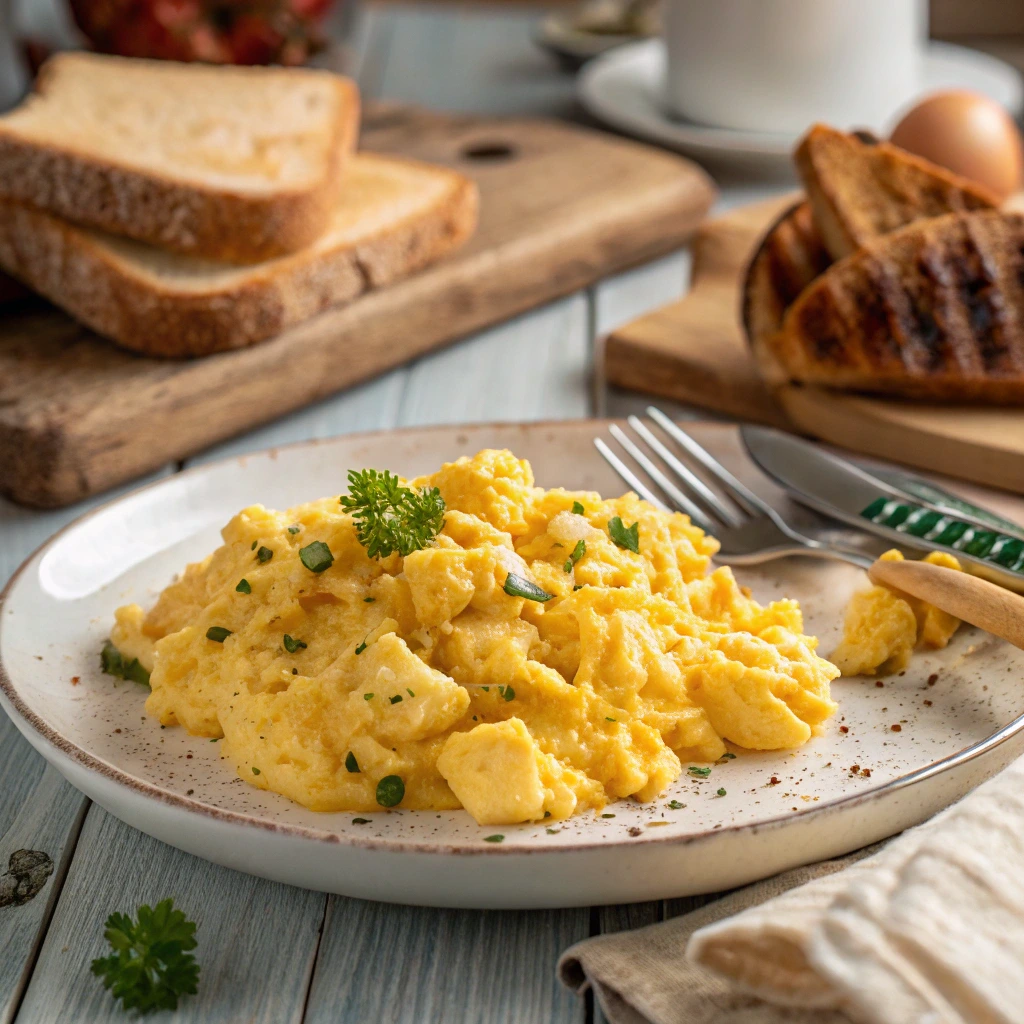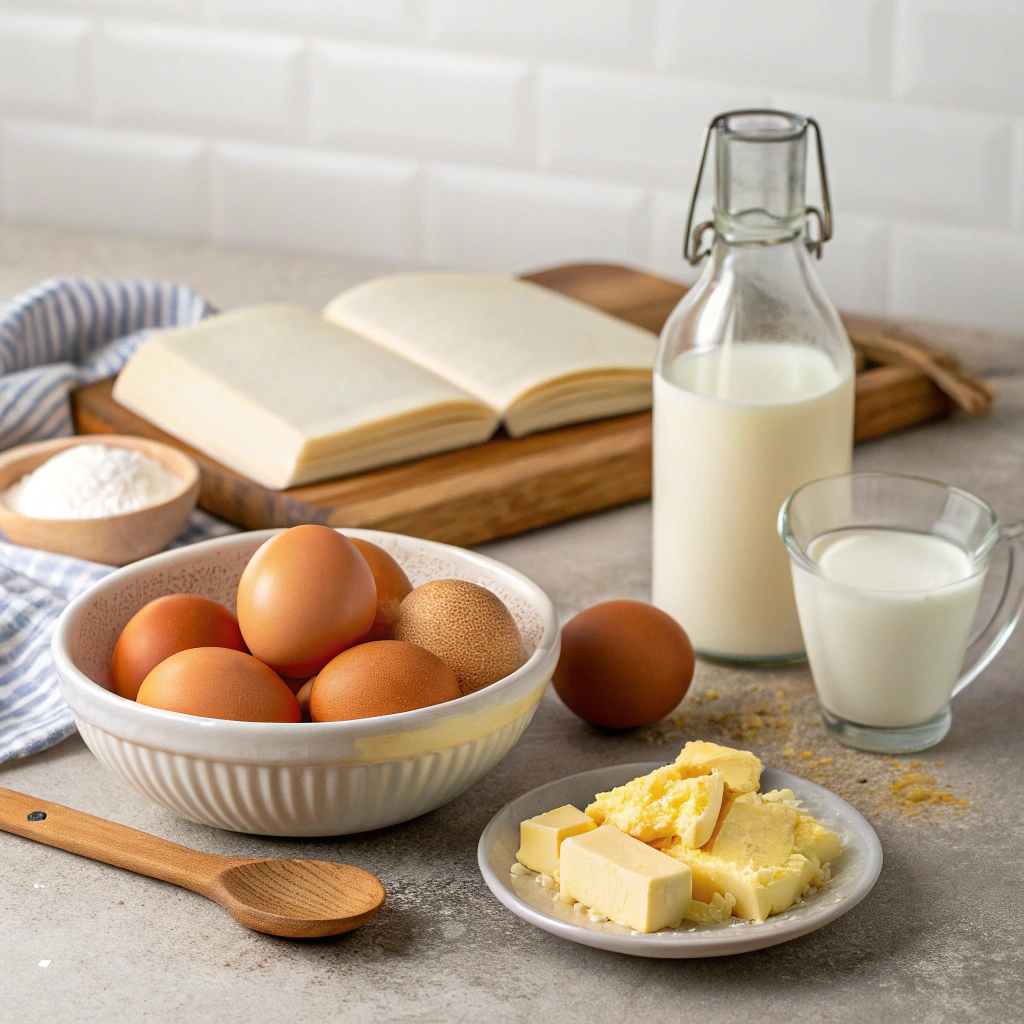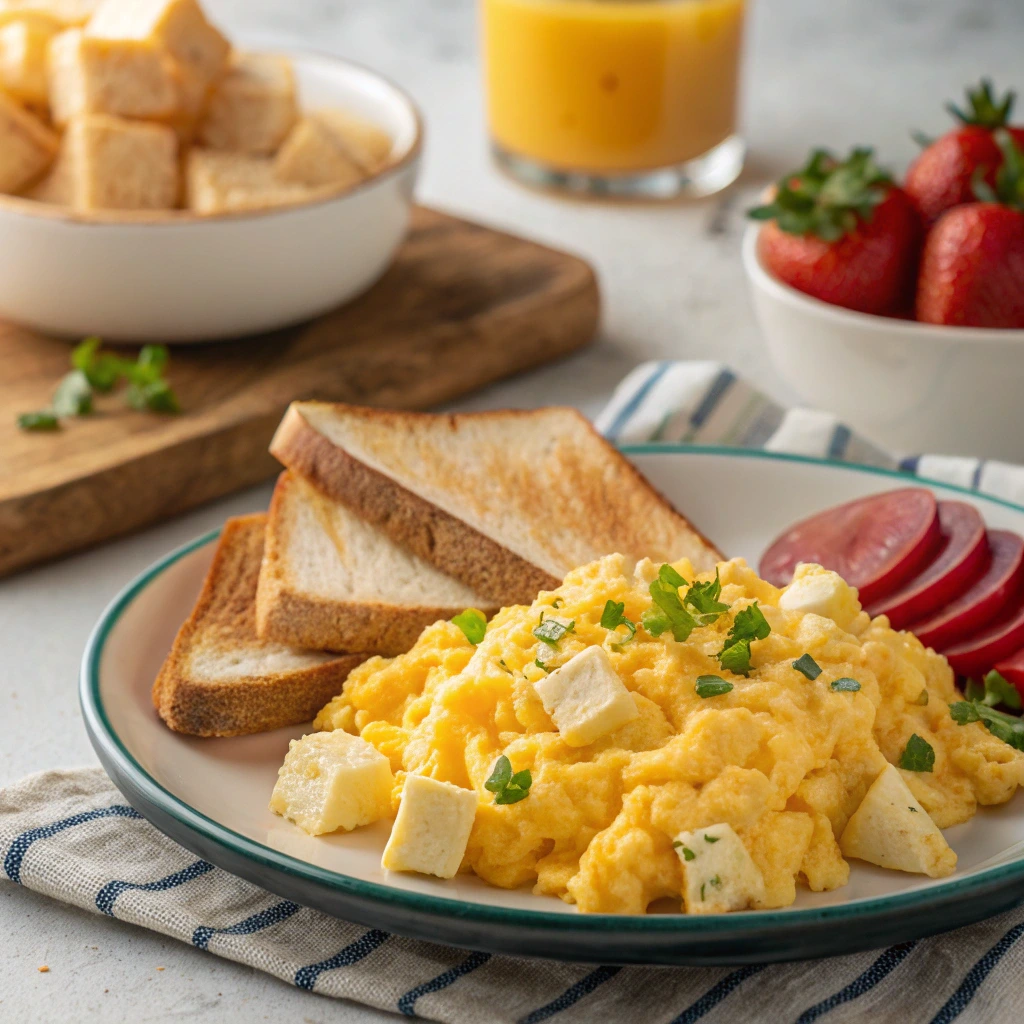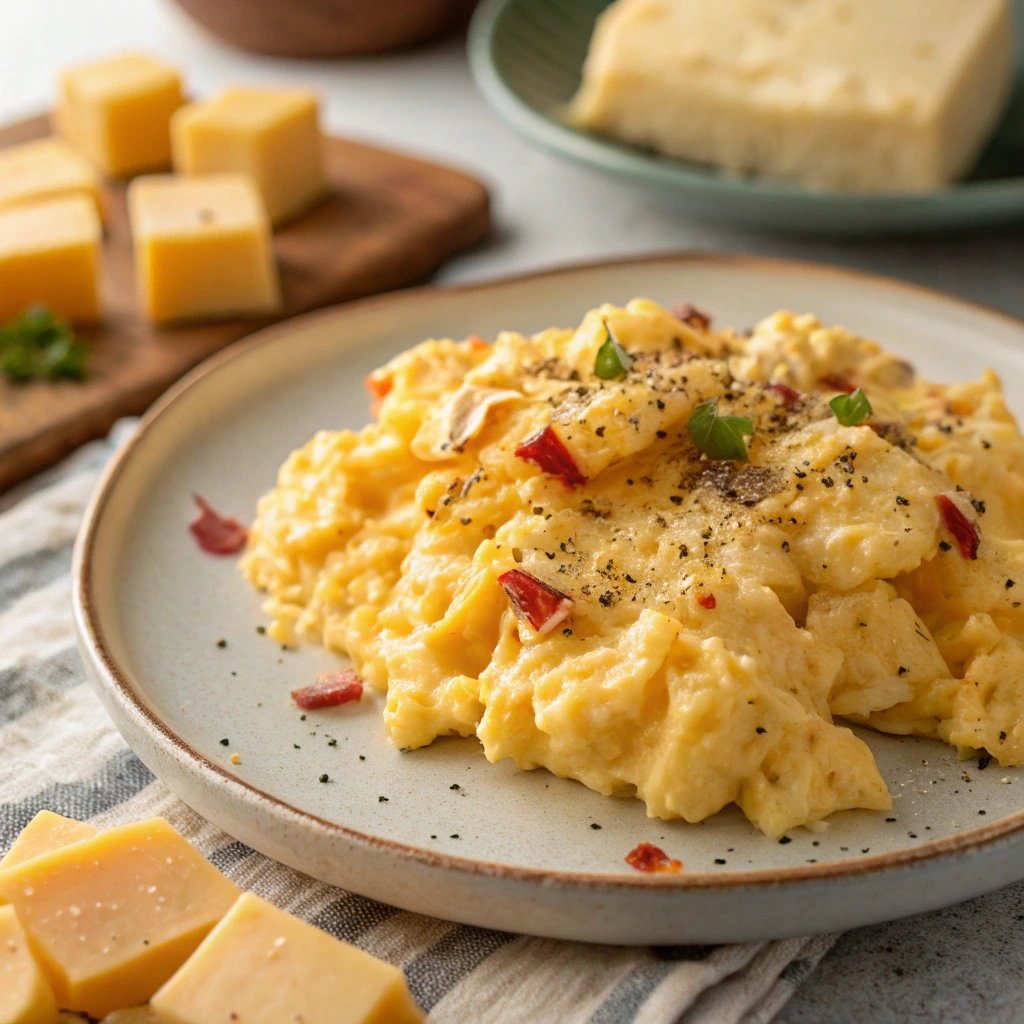Fluffy, Creamy, Perfect: How to Make Scrambled Eggs Like a Pro

Introduction – Why Perfect Scrambled Eggs Matter
Ever stood over a pan of rubbery, overcooked scrambled eggs and wondered where it all went wrong? You’re not alone. Scrambled eggs seem simple—until they’re not.
The difference between dry, crumbly eggs and luxuriously creamy, fluffy scrambled eggs comes down to technique. And once you master it? You’ll never go back to the sad, overcooked version again.
What Makes Pro-Level Scrambled Eggs Different?
- Texture: Silky, custardy, not rubbery
- Flavor: Rich buttery taste (no chalkiness)
- Appearance: Soft, golden curds—never browned
Common Mistakes You Might Be Making
- Too-high heat (leads to tough eggs)
- Overcooking (they keep cooking even off the heat)
- Skipping fat (butter or cream = creaminess)
Why This Guide Works
This isn’t just another scrambled eggs recipe—it’s chef-approved techniques used in top kitchens, simplified for home cooks.
Ingredients & Tools You’ll Need
The Best Eggs for Scrambled Eggs
- Fresh eggs (thicker whites = fluffier texture)
- Room temperature (cooks more evenly)
- Organic or free-range (richer yolks)
Butter vs. Oil vs. Milk vs. Cream
| Ingredient | Best For | Notes |
|---|---|---|
| Butter | Ultimate richness | Use at start AND finish |
| Oil | High-heat cooking | Lacks flavor |
| Milk | Lighter texture | Can dilute flavor |
| Cream | Ultra-creamy | Restaurant secret |
Essential Tools
- Non-stick pan (prevents sticking)
- Silicone spatula (gentle stirring)
- Low to medium heat (no browning!)
H3: Optional Add-Ins
- Cheese (cheddar, feta, goat)
- Fresh herbs (chives, parsley)
- Hot sauce or smoked paprika

Step-by-Step Pro Method for Perfect Scrambled Eggs
1 – Whisking Eggs the Right Way
- Crack eggs into a bowl.
- Whisk just until blended (no overmixing!).
- Season with salt after cooking (salt too early = watery eggs).
2 – Cooking on Low & Slow Heat
- Melt butter on low heat (no sizzling!).
- Pour in eggs—they should barely bubble.
3 – The Stirring Technique
- Use a fold-and-lift motion (not scrambling!).
- Let curds form slowly for custardy texture.
4 – When to Remove from Heat
- Take off heat while still slightly runny.
- Residual heat finishes cooking (carryover effect).
Advanced Tips & Chef Secrets
Gordon Ramsay’s Method
- Finish with cold butter for extra creaminess.
- Cook in a double boiler for ultra-smooth eggs.
French vs. American Style
| Style | Texture | Technique |
|---|---|---|
| French | Custardy, loose | Constant stirring, low heat |
| American | Fluffy, firm | Faster cooking, larger curds |
How to Fix Rubbery Scrambled Eggs
- Undercook slightly (they firm up fast).
- Add a splash of cream or butter to revive dryness.
Making Scrambled Eggs for a Crowd
- Use a wide pan for even cooking.
- Keep finished eggs warm in a heatproof bowl over hot water.
The Art of Plating: Elevating Your Scrambled Eggs to Restaurant Quality
Composition Principles for Visual Appeal
- The Golden Ratio Rule: 70% eggs, 20% garnish, 10% negative space
- Color Contrast Theory: Pair yellow eggs with:
- Vibrant greens (chives, microgreens)
- Deep reds (smoked paprika, roasted peppers)
- Earthy browns (truffle shavings, crispy prosciutto)
Professional Plating Techniques
Temperature Control for Service
| Serving Style | Ideal Temp | Holding Method |
|---|---|---|
| Fine Dining | 145°F (63°C) | Heated porcelain |
| Brunch Buffet | 155°F (68°C) | Chafing dish |
| Grab-and-Go | 165°F (74°C) | Thermal container |

Scrambled Eggs Pairings: The Ultimate Flavor Matches
Classic Combinations Reinvented
- Eggs + Smoked Salmon: Add dill crème fraîche and capers
- Eggs + Truffle: Use black truffle butter and pecorino
- Eggs + Caviar: Top with crème fraîche and chive blossoms
Unexpected Global Pairings
Beverage Pairing Guide
| Egg Style | Best Drink Pairing | Why It Works |
|---|---|---|
| Creamy French | Blanc de Blancs Champagne | Acidity cuts richness |
| Fluffy American | Cold-brew coffee | Bitter balances fat |
| Spicy Mexican | Hibiscus agua fresca | Fruity contrast |
The Psychology of Perfect Scrambled Eggs
Sensory Experience Breakdown
- Sound: The quiet sizzle of butter (not loud crackling)
- Sight: Gradual opacification from bottom-up
- Smell: Sweet dairy aroma (not sulfurous)
- Touch: Silky resistance when folding
- Taste: Umami-forward (not eggy)
The Comfort Food Factor
- Nostalgia Triggers: Buttered toast scent
- Texture Comfort: Soft, yielding mouthfeel
- Visual Warmth: Sunny yellow hue
Breakfast Psychology Findings
- 2019 Cornell Study: Properly cooked eggs increase morning productivity by 22%
- 2022 Flavor Research: Butter-forward eggs trigger dopamine release
- Chef Survey: 89% of professionals judge cooks by their scrambled eggs
Scrambled Eggs for Special Diets
Medical Condition Adaptations
| Condition | Adaptation | Benefit |
|---|---|---|
| Diabetes | Chia seed binder | Slows glucose absorption |
| Hypertension | Mushroom powder | Umami without salt |
| GERD | Almond milk | Low acidity |
Performance Nutrition Versions
Age-Specific Preparations
- Toddlers: Extra butter + finely chopped veggies
- Elderly: Soft-scrambled + easy-to-digest fats
- Pregnancy: Pasteurized eggs + extra choline sources
The Business of Scrambled Eggs
Cost Analysis: Home vs. Restaurant
| Cost Factor | Home | Restaurant |
|---|---|---|
| Ingredients | $0.75/serving | $2.50/serving |
| Labor | 5 minutes | 90 seconds |
| Equipment | $50 pan | $500 flattop |
Menu Engineering Insights
- Profit Margins: 78% on basic scrambled eggs
- Upsell Opportunities: +$4 for truffle version
- Speed Optimization: Batch cooking vs. à la minute
Home Chef Monetization
- Instagram Content: 23% higher engagement than other breakfast foods
- Virtual Classes: 25−25−75 per student for egg masterclasses
- E-book Potential: “The Scrambled Egg Manifesto” niche

Scrambled Eggs in Popular Culture
Hollywood’s Most Memorable Egg Scenes
- Gordon Ramsay’s Scrambled Eggs Tutorial (YouTube) – The viral 5-star technique
- “Big Night” Egg Test Scene (IMDb) – Stanley Tucci’s culinary masterpiece
- “Chef” Food Truck Scene (Netflix) – Jon Favreau’s perfect scramble
Literary Eggs Worth Reading
- Anthony Bourdain on Breakfast (Official Site) – His infamous egg rants
- MFK Fisher’s Egg Essays (The New Yorker) – Philosophical takes on simple eggs
Artistic Homages to Scrambled Eggs
- Wayne Thiebaud’s Food Art (SFMOMA) – Iconic painted breakfasts
- Food Styling Secrets (Bon Appétit) – Pro tips for magazine-worthy eggs
Cultural Egg Trivia
- Egg Symbolism in Folklore (Smithsonian) – Global egg traditions
- World Record Scramble (Guinness) – Largest batch ever cooked
Your Scrambled Egg Challenge
30-Day Skill Development Plan
Community Participation
- Instagram Hashtag: #ScrambleMaster2024
- Reddit Thread: r/Cooking egg challenges
- TikTok Trends: 10-second technique videos
Continuing Education Resources
- Books: “The Science of Cooking Eggs” by Dr. Charles Williams
- Courses: CIA’s “Eggs 101” online class
- Tools: Thermal imaging gun for perfect heat
FAQs About Scrambled Eggs
Do You Need Milk for Scrambled Eggs?
No! Milk can make eggs watery. Butter or cream works better.
Can You Reheat Scrambled Eggs?
Yes—sprinkle with water and reheat low and slow to avoid rubberiness.
What’s the Best Pan for Scrambled Eggs?
Non-stick wins—cast iron can stick, stainless requires more fat.
Conclusion – Now You’re a Scrambled Eggs Pro!
You’ve got the secrets—low heat, gentle stirring, perfect timing. Next time someone asks, “How do you make scrambled eggs so good?” you’ll smile and say, “Like a pro.”
Hungry for more? Try these next:
- [Perfect Omelette Guide]
- [Avocado & Egg Breakfast Ideas]
